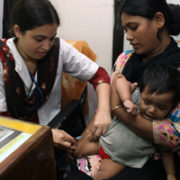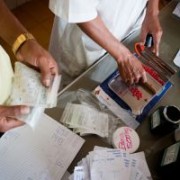Archive | Health RSS feed for this section
Health
 Health
Health
 Health
Health
 Health
Health

Innovation in health care in South Asia

The countries comprising the South Asian Association for Regional Cooperation (SAARC) region (India, Pakistan, Bangladesh, Nepal, Bhutan, Afghanistan, Sri Lanka, and the Maldives) commonly known as South Asia face serious healthcare affordability and accessibility challenges. According to World Bank national estimates, South Asian countries houses more than 390 million poor people and a very significant percentage of total population lies below national poverty line (Figure 1). This large number of population is quite unlikely to afford private healthcare services and heavily dependent on the public healthcare facilities.
Rapid growth of overweight and obesity in Indonesia: Increasing risk for the poor

New ADBI research (Aizawa and Helble, forthcoming) studies how overweight and obesity have become major threats to public health in Indonesia. The evidence shows that obesity, which was previously a problem among high-income groups in the country, has spread across all income groups. Obesity in the lower-income groups, in particular, has been rising rapidly. Overweight and obesity significantly increase the risk of suffering from a large number of chronic conditions. Lower income groups are particularly ill-prepared to face continuously high health expenditures, as health systems remain weak. Urgent policy action is needed to mitigate the risk of these groups of falling into poverty due to high health expenditures caused by diseases related to obesity.
5 reasons to be worried about health security in Asia

If you live in Asia and the Pacific, do you ever wonder how high your risk is of contracting antimicrobial-resistant bacteria or emerging infectious diseases such as a new strain of avian influenza? Unfortunately, I have to tell you that the risk here is higher that in any other region in the world.
Impact of universal health coverage: A micro-founded macroeconomic perspective

Universal health coverage (UHC) has become a key agenda of policy makers in many countries. According to the definition of the World Health Organization (2010), UHC is the goal that “all people have access to health services and do not suffer financial hardship in paying for them.” In most developing countries, the goal of UHC is not easy to reach due to the fact that large, resource-poor populations have limited access to health services. Given that resource-poor people cannot afford out-of-pocket health expenditures, or can only afford them by sacrificing other priorities, a health financing system where people are required to pay for use directly is one of the major barriers to reaching UHC. Although cost sharing is necessary to prevent the overutilization of health services arising from the potential problem of moral hazard, universal coverage is more likely to be reached when the out-of-pocket ratio for direct payment is sufficiently low.


Search
Subscribe / Connect to Asia Pathways
Subjects
- Agriculture and natural resources
- Capacity development
- Climate change
- Economics
- Education
- Energy
- Environment
- Finance sector development
- Gender
- Governance and public sector management
- Health
- Industry and trade
- Information and Communications Technology
- Infrastructure
- Making Cities More Livable
- Miscellaneous
- Population
- Poverty
- Private sector development
- Regional cooperation and integration
- Sanitation
- Social development and protection
- Subjects
- Transport
- Uncategorized
- Urban development
- Video Blog
- Water
Recent Posts
- Rethinking High-Rise Living: Balancing Urban Growth and Sustainability in Asia’s Cities
- Navigating Linear Transport Infrastructure Through Conservation Landscapes
- How Are Technology Trends Shaping the Future of Insurance?
- Securing Asia’s Future Through Soil Health: Why It Matters and What Must Be Done
- Silent Struggles: Advancing Women’s Mobility with Public Transportation in Asia




Recent Comments